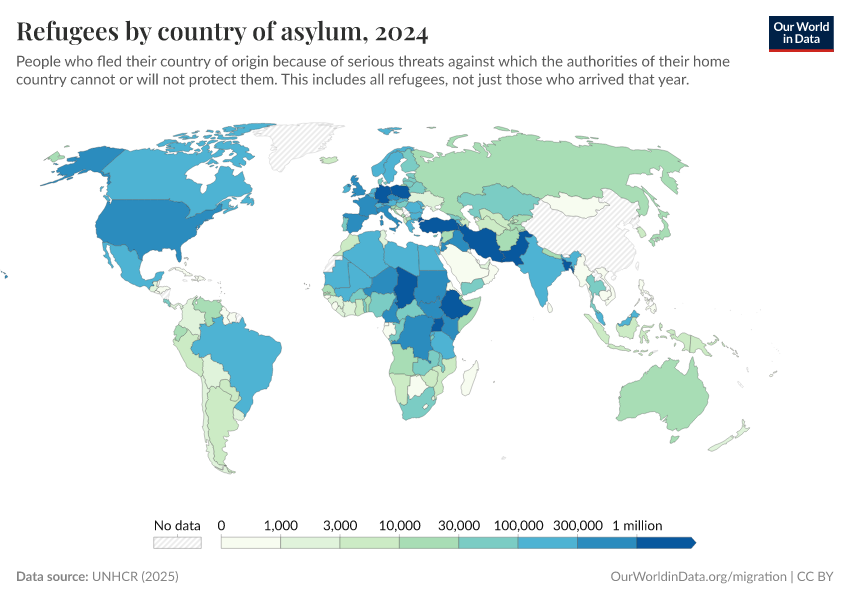Refugees by country of asylum

What you should know about this indicator
A refugee is a person in need of international protection, who had to flee their home country because of serious threats against which the authorities of their home country cannot or will not protect them.
What you should know about this indicator
A refugee is a person in need of international protection, who had to flee their home country because of serious threats against which the authorities of their home country cannot or will not protect them.
Sources and processing
This data is based on the following sources
How we process data at Our World in Data
All data and visualizations on Our World in Data rely on data sourced from one or several original data providers. Preparing this original data involves several processing steps. Depending on the data, this can include standardizing country names and world region definitions, converting units, calculating derived indicators such as per capita measures, as well as adding or adapting metadata such as the name or the description given to an indicator.
At the link below you can find a detailed description of the structure of our data pipeline, including links to all the code used to prepare data across Our World in Data.
Notes on our processing step for this indicator
- The United Nations High Commissioner for Refugees (UNHCR) collects data on refugee populations for each country of origin and country of asylum separately. To calculate the total number of refugees living in a country, we sum up the data from all origin countries. To calculate the total number of refugees from a country, we sum up the data from all asylum countries.
- To calculate the number of refugees per 1,000 or 100,000 people in a country, we divide the number of refugees by the total population of the country (for the same year) and multiply by the factor. The population estimates come from a long-run dataset maintained by Our World in Data.
- We remove refugee populations where the country of origin and country of asylum are the same, as refugees are defined as people who have fled their country and crossed an international border. We also remove asylum seekers where the country of origin and country of asylum are the same.
- We remove data for China after 2020 due to a large data discontinuity.
Reuse this work
- All data produced by third-party providers and made available by Our World in Data are subject to the license terms from the original providers. Our work would not be possible without the data providers we rely on, so we ask you to always cite them appropriately (see below). This is crucial to allow data providers to continue doing their work, enhancing, maintaining and updating valuable data.
- All data, visualizations, and code produced by Our World in Data are completely open access under the Creative Commons BY license. You have the permission to use, distribute, and reproduce these in any medium, provided the source and authors are credited.
Citations
How to cite this page
To cite this page overall, including any descriptions, FAQs or explanations of the data authored by Our World in Data, please use the following citation:
“Data Page: Refugees by country of asylum”, part of the following publication: Fiona Spooner, Tuna Acisu, Simon van Teutem, Hannah Ritchie, Esteban Ortiz-Ospina, Marcel Gerber, and Max Roser (2022) - “Migration”. Data adapted from UNHCR. Retrieved from https://auto-epoch.owid.pages.dev:8789/20250909-093708/grapher/refugee-population-by-country-or-territory-of-asylum.html [online resource] (archived on September 9, 2025).How to cite this data
In-line citationIf you have limited space (e.g. in data visualizations), you can use this abbreviated in-line citation:
UNHCR (2025) – with major processing by Our World in DataFull citation
UNHCR (2025) – with major processing by Our World in Data. “Refugees by country of asylum” [dataset]. UNHCR, “Refugee Population Statistics Database Annual statistics for 2024” [original data]. Retrieved November 1, 2025 from https://auto-epoch.owid.pages.dev:8789/20250909-093708/grapher/refugee-population-by-country-or-territory-of-asylum.html (archived on September 9, 2025).